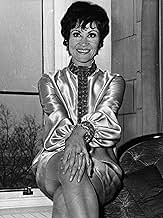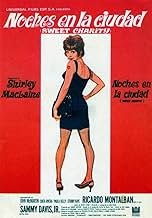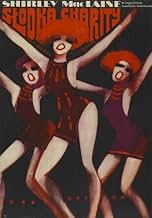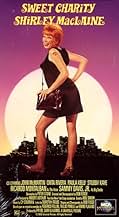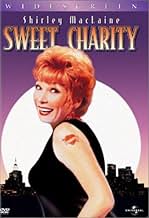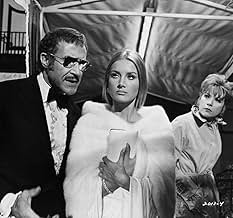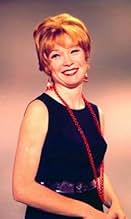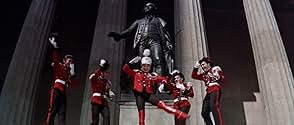Sweet Charity
- 1969
- Tous publics
- 2h 29m
IMDb RATING
6.9/10
7.3K
YOUR RATING
A luckless taxi dancer in New York City seeks a better life and finds love along the way.A luckless taxi dancer in New York City seeks a better life and finds love along the way.A luckless taxi dancer in New York City seeks a better life and finds love along the way.
- Nominated for 3 Oscars
- 6 nominations total
Dante DiPaolo
- Charlie
- (as Dante D'Paulo)
Leon Alton
- Dancer
- (uncredited)
Featured reviews
10zetes
There's just something about this movie that I love. I had seen bits and pieces of it some half a dozen times in the past couple of years. Tonight I finally sat and watched all of it. In theory it sounds like blasphemy: a musical remake of Fellini's Nights of Cabiria. But somehow first time director Bob Fosse pulls it off, and enormously well. Fosse is daring and innovative in his direction. Not just in the musical numbers, where you would expect it, but in every scene. He plays, and he's obviously having a ball. After the direction, a high percentage of the film's success is due to Shirley MacLaine, who was never better as Charity Hope Valentine. As much as I love and care for Giullieta Masina's Cabiria, I love and care for MacLaine's Charity. She's such an enormously lovable character, and MacLaine is simply brilliant. Her comic timing is impeccable. Sweet Charity also proves an interesting time capsule of late 60s New York City. In the scene cognate to the Picadilly Club in Nights of Cabiria, we visit a trendy night club where the girls where blue feathers as hats. Clips of Cleopatra (the one with Claudette Colbert) and an unidentifiable W.C. Fields movie play on a big screen in the background. We visit a religious ceremony for hippies who sing The Rhythm of Life. Sammy Davis Jr. is the priest! In Cabiria, a parade of young people cheer her at the end of the film. In Sweet Charity, a group of hippies, amongst them a young Bud Cort, hand out flowers in the morning, just saying good morning to everyone they meet. This movie was a huge bomb when first released. Fosse is actually really lucky they gave him another chance at direction, and then he made a film instantly recognizable as a masterpiece, Cabaret. Sweet Charity did not deserve to fail so miserably. Just the fickle fingers of fate, I guess.
Great Sets, choreography, music, cast. "If They Could See Me Now" is worth the price of admission. "I'm A Brass Band" is also a highlight. Somewhat depressing story line makes this a happy/unhappy experience. But if you haven't seen it, give it a whirl. I hear the DVD has an alternate ending, which may be a good idea!
This is loaded to the brim with that dancing and just general idiosyncratic "cool" feeling that made Fosse who he was as a creator. "Big Spender" and "If My Friends Could See Me Now" are all-timer Musical numbers in film history. And yeah, a couple of the numbers have certainly dated (hearing Sammy Davis tell a bunch of Broadway Hippies to "Sock it to me" in the "Rhythm of Life" number is worth a major eye-roll), plus Fosse's attempts to do uh La Jetee type still image montages at a couple of points. However, Shirley MacLaine is often so moving in a role that others might have played a little less intensely felt (what sold me was the job interview scene, which is just about perfect, but her comic timing is impecable). She's adorable but also very serious as a person, which is hard to pull off.
It's big and flashy and a little bit silly (I like to call Ricardo Montalban Casanova Khan in this), and the director jumps off from Fellini and Neil Simon (in a Peter Stone script) for as much audacious advantage as he can. Not all of it works, but it's far from a "disaster" like Pauline Kael called it. 7.5/10
My love and admiration for Federico Fellini/Guiletta Masina's film Nights of Cabiria had stopped me for long time from seeing Sweet Charity, the adaptation of the musical based on the same story which was made into a highly successful Broadway show directed and choreographed by a multi talented Bob Fosse. I am a fan of Bob Fosse. I love all his films, musicals and not, but I was hesitant to see Sweet Charity the movie and I never had a chance to see the Broadway musical. Well, I finally did and I can say that nothing is wrong with transporting the same story to the different time, place, language, medium, and to use the different artistic tools. The story is the same; the films are as different as Rome and NYC or as Federico Fellini and Bob Fosse. Fosse's film should be judged on its own terms, and it has a lot of breathtaking scenes to enjoy, bright colors, outrageously stunning costumes (the work of incredible Edith Head), adorable and unbelievably cute Shirley MacLaine, Sweet Charity Hope Valentine, and the best of all - the dancing sequences to die for. Among them, splendid The Big Spender is perfection and the real treasure. Fosse's staging of the musical numbers is outstanding. The most memorable moment in the movie for me was stolen from Shirley MacLaine by Chita Rivera in Big Spender. Just watch Rivera's seemingly boneless arms, the right one around her head and the left one behind her back, the left hand on her right hip as she sings, "do you want to have fun, fun, fun?" For this moment alone, I like the film even if I see very well that it has some minuses, too. The first act between two intermissions was really good, and it includes the best dancing and singing numbers: "Hey, Big Spender", "The Pompeii Club", "Rich Man's Frug", and "If They Could See Me Now". After the second intermission the movie went over the hill. I believe that it could do without both intermissions. We are not watching the show at the theater, and the intermissions only took time. The "hippiest" "Rhythm of Life" scene was overlong, did not make much sense, and made me want to fast-forward it. I take it that Fosse wanted to experience with the camera movements and different techniques in his very first feature film which was a screen transfer of his Broadway Musical. This is the only explanation of his multiple slow-motions, stills, color/black/white and back changes that did not add anything to the film, just paused it with no apparent reasons. His next screen adaptation was timeless Cabaret, and he had improved his directing style dramatically. As the result, Cabaret has stayed his greatest achievement along with All That Jazz.
Coming back to the original tragic comedy "Nights of Cabiria", of all the characters Fellini had given life on screen, by his own words, Cabiria was the only one he worried about many years after the film was made. Of all the characters, I've seen in films, Cabiria is the one I often think about - whatever happened to her? Did she survive? Was she able to find love? As much as I like Shirley MacLaine/Charity, I did not worry about her future. She lived happily ever after - in both movie endings, theatrical and alternative.
Coming back to the original tragic comedy "Nights of Cabiria", of all the characters Fellini had given life on screen, by his own words, Cabiria was the only one he worried about many years after the film was made. Of all the characters, I've seen in films, Cabiria is the one I often think about - whatever happened to her? Did she survive? Was she able to find love? As much as I like Shirley MacLaine/Charity, I did not worry about her future. She lived happily ever after - in both movie endings, theatrical and alternative.
I notice that uncredited, but still making a vital contribution to this film was the original Broadway lead Gwen Verdon who assisted her then husband Bob Fosse with the choreography. This has to be one of the truly unselfish acts in a business that's built on ego.
Sweet Charity ran 608 performances on Broadway with a flock of Tony Award nominations including Gwen Verdon for the lead of Charity Hope Valentine and two Tony Awards for Bob Fosse for direction and choreography. Fosse came over to Hollywood to repeat his dual roles. But instead of Gwen doing the lead, Shirley MacLaine steps into the part and Gwen assists in the choreography. Quite frankly had she told Universal and her then husband to take their film and follow explicit directions what to do with it, who could have blamed her.
Yet there was Gwen Verdon, helping another performer do good in a part she created. Shirley MacLaine did do good in the role and it was a return to MacLaine's own musical roots. Shirley MacLaine has done so many dramatic roles and been Oscar nominated and once a winner for them, people do forget her beginnings were musical. Had she come along ten years earlier she would have been a great musical star. As it is she does have films like Can Can, Artists and Models, and What A Way To Go where we see Shirley singing and dancing. Her first big break was on Broadway replacing Carol Haney in Pajama Game.
Charity Hope Valentine, someone who is charging more than 10 Cents a Dance Depression prices in a dance hall keeps having the worst luck in men which is established early on when at the beginning a guy she was just getting interested in threw her off a bridge into Central Park lake and robbed her purse. The latest in a long line of romantic failures. But quite by accident she gets involved with two men, Italian film star Ricardo Montalban and insurance actuary John McMartin who is repeating his role from the original Broadway production.
The Cy Coleman-Dorothy Fields score is a bit cut down, but you couldn't do Sweet Charity without Hey Big Spender and If They Could See Me Now. In the latter Shirley's musical talents, singing and dancing, get their full range. It must have been something however to see Gwen Verdon cavorting around the Italian film star's apartment doing that soliloquy of finally hitting the big time and wishing her dance hall girls could see here.
As for the dance hall girls, Shirley's peers are led by best friends Chita Rivera and Paula Kelly who along with Shirley do the big production number of Hey Big Spender. Who wouldn't want a little quality time with any one of them.
And we get a special treat with Sammy Davis, Jr. doing the Rhythm Of Life church, a satire on those who claim religious tax exempt status for some interesting beliefs. It maybe his best musical moment in film.
The ending for a musical is rather unusual, I can't reveal, but nothing similar comes to mind at the moment. Though Shirley MacLaine is great, poor Gwen Verdon died having only had one of her Broadway hits filmed, Damn Yankees.
But Gwen was quite the girl helping someone else score a hit with her role.
Sweet Charity ran 608 performances on Broadway with a flock of Tony Award nominations including Gwen Verdon for the lead of Charity Hope Valentine and two Tony Awards for Bob Fosse for direction and choreography. Fosse came over to Hollywood to repeat his dual roles. But instead of Gwen doing the lead, Shirley MacLaine steps into the part and Gwen assists in the choreography. Quite frankly had she told Universal and her then husband to take their film and follow explicit directions what to do with it, who could have blamed her.
Yet there was Gwen Verdon, helping another performer do good in a part she created. Shirley MacLaine did do good in the role and it was a return to MacLaine's own musical roots. Shirley MacLaine has done so many dramatic roles and been Oscar nominated and once a winner for them, people do forget her beginnings were musical. Had she come along ten years earlier she would have been a great musical star. As it is she does have films like Can Can, Artists and Models, and What A Way To Go where we see Shirley singing and dancing. Her first big break was on Broadway replacing Carol Haney in Pajama Game.
Charity Hope Valentine, someone who is charging more than 10 Cents a Dance Depression prices in a dance hall keeps having the worst luck in men which is established early on when at the beginning a guy she was just getting interested in threw her off a bridge into Central Park lake and robbed her purse. The latest in a long line of romantic failures. But quite by accident she gets involved with two men, Italian film star Ricardo Montalban and insurance actuary John McMartin who is repeating his role from the original Broadway production.
The Cy Coleman-Dorothy Fields score is a bit cut down, but you couldn't do Sweet Charity without Hey Big Spender and If They Could See Me Now. In the latter Shirley's musical talents, singing and dancing, get their full range. It must have been something however to see Gwen Verdon cavorting around the Italian film star's apartment doing that soliloquy of finally hitting the big time and wishing her dance hall girls could see here.
As for the dance hall girls, Shirley's peers are led by best friends Chita Rivera and Paula Kelly who along with Shirley do the big production number of Hey Big Spender. Who wouldn't want a little quality time with any one of them.
And we get a special treat with Sammy Davis, Jr. doing the Rhythm Of Life church, a satire on those who claim religious tax exempt status for some interesting beliefs. It maybe his best musical moment in film.
The ending for a musical is rather unusual, I can't reveal, but nothing similar comes to mind at the moment. Though Shirley MacLaine is great, poor Gwen Verdon died having only had one of her Broadway hits filmed, Damn Yankees.
But Gwen was quite the girl helping someone else score a hit with her role.
Did you know
- TriviaAlthough uncredited, Gwen Verdon was assistant choreographer in the film version of Sweet Charity (1969).
- GoofsIn the "Aloof" movement of "The Rich Man's Frug," two of the male principal dancers walk down the stairs to light a woman's cigarette, while the others dance behind them. The background choreography in this shot leads directly to the triangle formation of the next shot, and the two men are now in the middle of the group, although there was no time for them to reach that position.
- Quotes
Charity Hope Valentine: Wow! This place sure is crawlin' with celebrities. I'm the only person here I never heard of.
- Alternate versionsLaserdisc version contains an alternative ending. After Oscar leaves Charity, he starts to go crazy in his apartment. He then realizes that despite Charity's faults, he really can't live without her. He finds Charity on the bridge in Central Park and, thinking she's going to jump, falls into the river. Charity jumps in after Oscar and forgives him. The two then walk off together, soaking wet, through the park. Bob Fosse thought this ending was too corny, and decided to use the depressing, yet more inspirational, ending for the film's major release.
- ConnectionsFeatured in Sweet Charity: From the Stage to the Screen (1969)
- SoundtracksMy Personal Property
(uncredited)
Music by Cy Coleman
Lyrics by Dorothy Fields
Performed by Shirley MacLaine
- How long is Sweet Charity?Powered by Alexa
Details
- Release date
- Country of origin
- Language
- Also known as
- Sweet Charity: The Adventures of a Girl Who Wanted to Be Loved
- Filming locations
- Production company
- See more company credits at IMDbPro
Box office
- Budget
- $20,000,000 (estimated)
- Runtime2 hours 29 minutes
- Aspect ratio
- 2.35 : 1
Contribute to this page
Suggest an edit or add missing content


